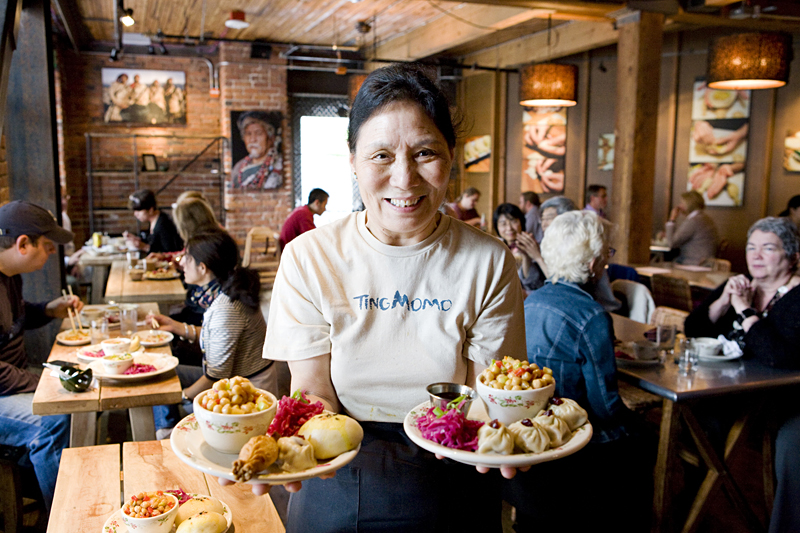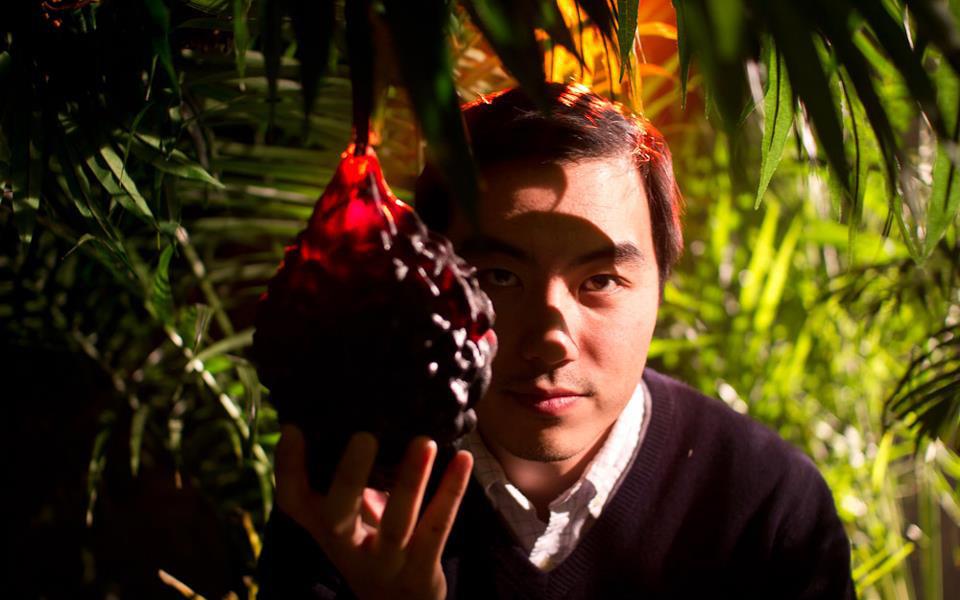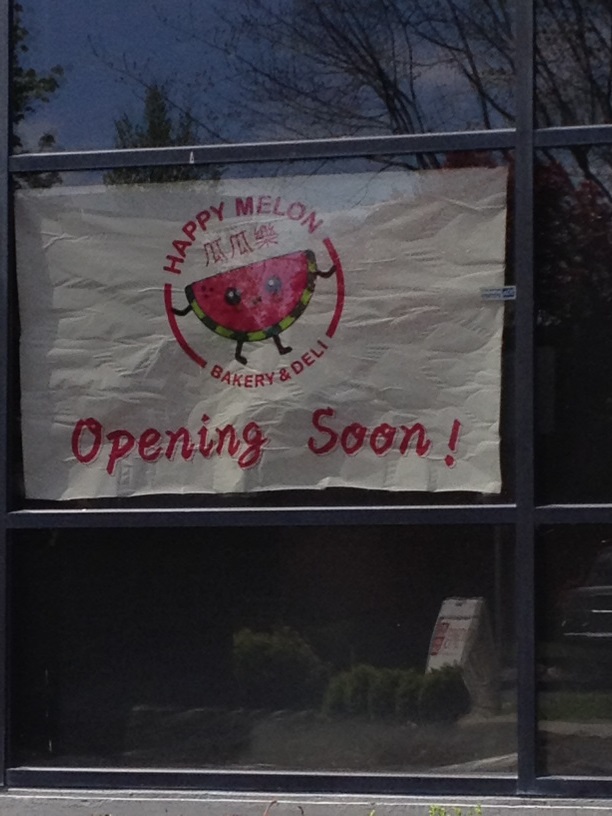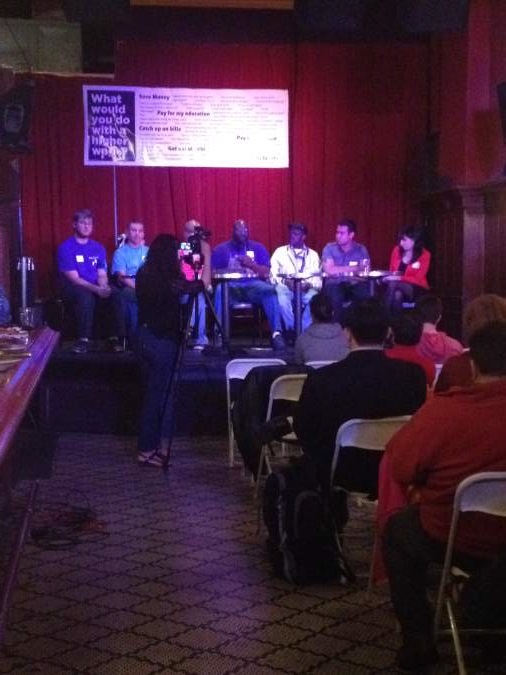It’s a shame for Tom Douglas that the USDA retired its food pyramid before the Pharaonic restaurateur could secure naming rights to its base level of bread and pasta. At Douglas’ new trio of South Lake Union restaurants, the bustling kitchens have their way with grains, churning out a global array of carbohydrate-packed plates.
On the ground floor of the boxy brick building that houses all three eateries, the cooks at Cuoco twist and trim noodle dough into mops of spaghetti and sheets of lasagna. Upstairs at Ting Momo, Douglas’ longtime Dahlia Lounge chef, Dekyi Thonden, folds dumplings. And on the other side of a Tibetan cotton curtain, at Brave Horse Tavern, bakers keep wire bushel baskets heaped high with chewy Bavarian pretzels. It’s a stunning excavation of the world’s bread box.
While the three restaurants share a roof (and, on the second floor, restrooms), the hydra doesn’t function like a food court. Diners who opt for the civility of prosecco and lardo crostinis at Cuoco may have no clue that hundreds of Amazon employees are congregated overhead, pouring pints from sloshing pitchers of Olympia lager and settling office squabbles on the shuffleboard tables.
The setup is reminiscent of a cruise ship, where cheek-by-jowl themed restaurants operate as seemingly independent entities. And just as cruise passengers are fated to try the pizza parlor, steakhouse, and Asian stir-fry bar before docking, eaters situated anywhere near the thriving South Lake Union district are likely to visit all three of Douglas’ Terry Avenue outlets. Here then is a tour of the 10th, 11th, and 12th restaurants in Douglas’ Seattle portfolio.
Check out a “Food Porn” slideshow from Tom’s SLU trifecta.
Ting Momo is the outlier of the building’s culinary combo. It’s open only for lunch, and doesn’t feature any dishes for which neighborhood office workers are likely to harbor innate cravings. But much as grateful monarchs bestowed estates upon noblemen who led their subjects to victory in battle, Douglas has given Thonden a restaurant to show his appreciation for her work. There might as well be a giant red bow on the front door.
Traditional Tibetan cuisine centers on yak and barley, but Thonden leans heavily on a band of seasonings that are so critical to her cooking that a few of them are showcased in glass spice jars near the cash register (while the other restaurants also keep lunch hours, Ting Momo is the only one which offers counter service). There’s tamarind, cumin, and orange zest, a mix that becomes monotonously familiar halfway through the restaurant’s short menu.
Ting Momo serves three styles of dumplings; a grassy coconut milk–based soup with shiitake mushrooms and too-gummy noodles; and a daily special, which is often rather soupy too. The most popular order is an Azag Azog plate, crammed with one of each dumpling type, a teacup of underseasoned chickpea salad, and a skein of pickled cabbage as purple as Jane Fonda’s workout tights. Visually, it’s a captivating plate.
Like jelly spilling from a doughnut, a bit of tender yak meat pokes its way out of the crimped steamed dumpling, or momo, slender as a clam. Unfortunately, the dumpling itself is gluey and bland. A pork-fried dumpling, or samo, is greasy, and a rotund, soft steamed dumpling, or tingmo, stuffed with mushrooms and threads of bamboo, is a disappointingly spongy bun.
It’s conceivable that Thonden has become overwhelmed by the crowds who pack the boardinghouse-style tables in her supremely energetic red-walled dining room. Lunchers wielding chopsticks are forever clanging elbows, and staffers struggle to keep up with the endless busing duties.
There are hints that Ting Momo will sparkle once the restaurant overcomes its opening jitters. A single potato samo was among the best things I ate at any of the Terry Avenue restaurants. Fried golden, the two-bite dumpling was an optical doppelgänger for a tiny chicken drumstick, right down to its rounded cloverleaf end. The gorgeous samo encased potatoes and peas dashed with a bright, aromatic curry, and tasted like a Himalayan shepherd’s pie.
While the clientele at Cuoco skews older than that of Brave Horse and Ting Momo, I wouldn’t wish the restaurant on anybody old enough to remember trading a radio for a television. The prices are often ludicrously high, and the portions are measly.
I don’t mind shelling out three bucks for bread when it’s as lush and nutty as the bread Cuoco produces. But I took affront at a $4 dish of three tightly wound fiddlehead-fern tops, each no bigger than a subway token, capped with squares of La Tur so tiny it was impossible to appreciate the Italian cheese’s oozy runniness.
There’s steak ($55 buys 24 ounces of dry-aged beef), fish, pork, and guinea hen at Cuoco, but the menu’s dominated by 10 pastas, about half of which are made in-house. Here too, portions pose problems. The server on our first visit couldn’t quite say how many pastas we should order. Since the dishes are priced between $12 and $25, we assumed one apiece would suffice after a smorgasbord of antipasti (this was pre- fiddlehead encounter), but the server advised sharing at least three or four.
A few of the pastas are excellent. The delicate lasagna, layered with béchamel and a faintly tannic Bolognese, justly surged with pride at transcending its potluck reputation. Tagliatelle decorated with sausage and kale had a fine chew. Yet when the noodles were gone, the bowl was disconcertingly shiny: Most of the pastas I sampled were drowning in butter and oil.
The glitch is accentuated in filled pastas, including a rabbit-and-veal agnolotti slick with marjoram butter and greasy, elastic gnocchi soaked in a primeval nettle pesto and bedecked with raw hazelnuts. Yet some dishes match the upscale earthiness of the candlelit room, smartly furnished with paisley table linens, terra-cotta-style plates, and a zillion little design touches that speak to Douglas’ knack for creating restaurant spaces. A starter of jelly-textured cured beef vibrates with rosemary, and a duck-gizzard spiedini offers an enjoyably coarse riff on summer grilling. The skewered meat, bathed in oil-rich green-garlic vinaigrette, suns on a slice of bread waxed with rhubarb. There’s much to like about a lark of a calamari preparation, featuring spicy sausage looped through pliable rings of bronzed squid and plated with fat cannellini beans.
For those collecting stamps on their Tom Douglas passports, desserts at Cuoco feel repetitive. All the desserts originate at Dahlia Bakery, so Cuoco serves rice pudding, same as Ting Momo, and a rhubarb crostata that’s nearly indistinguishable from the cherry pie served at Brave Horse Tavern, the clear winner of this three-restaurant race.
The brave horse from which the tavern component of the Terry Avenue complex takes its name is apparently a muscle-bound quarter horse with flaring nostrils and a spurs-wearing rider (there’s a picture on the restaurant’s website). But Brave Horse Tavern‘s spectacularly on-target cuisine doesn’t have anything to do with chaps or cowboys.
The horse the menu evokes is Brown Beauty, the mare that Paul Revere mounted for his legendary ride. Here is a noisy republican tavern with a small “r,” proffering a cuisine—pretzels and pork and untold gallons of ale—that would have been recognizable to Americans when the vast majority of Anglos came from British or German stock.
It’s possible to get a shot of Bailey’s or bourbon at Brave Horse, but the food is engineered to pair with beer. There are more than a dozen on tap, but I never got past the malty, hoppy India Pale Ale brewed for Brave Horse by Schooner Exact Brewing Company in SoDo. The mahogany beer is nearly the same shade as the superlative pretzels, made with lye so the exterior bakes to a ravishing brown while the interior remains doughy and soft. The warm pretzels, glimmering with salt, have the clout of artisanal bread and the airy lightness of a silly snack tied in a knot.
Most everyone at Brave Horse ends up eating pretzels. Seating at the restaurant is communal and the restaurant is perpetually crowded, so it’s impossible to avoid being in close proximity to a pretzel. For pretzel fans with aspirations beyond mustard, Brave Horse serves a pretzel with three dips: pimento cheese (made with such high-quality white cheddar that I imagine the prep cook winced when he had to muss the curds with jalapenos), a singed-tasting peanut butter and bacon, and a refreshing, oniony sour cream that could have been piled on a pierogi. There’s also a selection of saucy, salty meat snacks for pretzel-swiping, including a trough of smoky cocktail wieners afloat in hot yellow mustard.
Brave Horse’s burger could probably glide to greatness on the strength of its Dahlia Bakery–made bun, but the beef’s not bad either. The patty is slightly thicker than a slider, and swamped with a tomato-vinegar sauce that was probably applied a mite too enthusiastically.
Yet I couldn’t quibble about anything made with pig, including an appetizer of pickle-rich deviled eggs topped with ribbons of green garlic and bacon confetti. I adored a Teutonic slab of pork shoulder smeared with sweet onions, and immediately regretted allowing my server to take my plate before I’d cleaned it.
A meal at Brave Horse should end with the cherry pie, which pairs with beer as well as the courses which preceded it do. The personal-sized pie is flaky, sour, and exactly what Revere would order—assuming he could find a seat.
PRICE GUIDE
Ting Momo
Yak momo plate $9
Potato samo plate $8
Mushroom tingmo plate $8
Azag Azog combo $10
Cuoco
Cured beef loin $5
Duck gizzard spiedini $10
Gnocchi $14
Lasagna $19
brave horse tavern Pretzel $4
Deviled eggs $6
Burger $6
Pork shoulder $8








